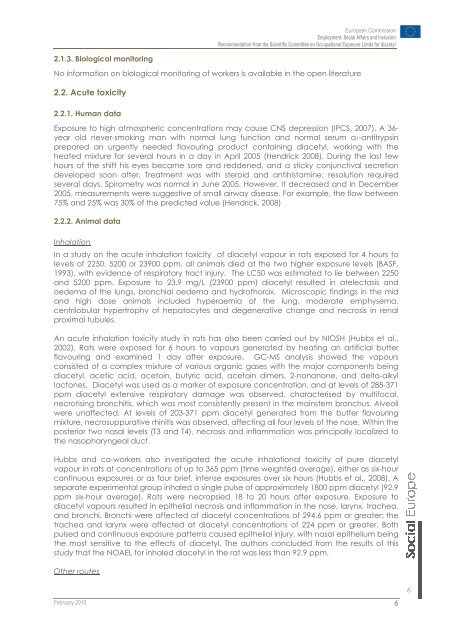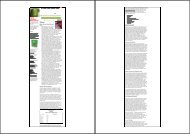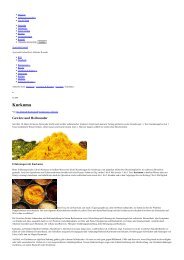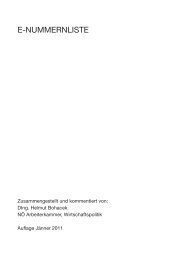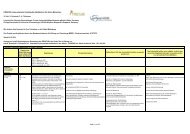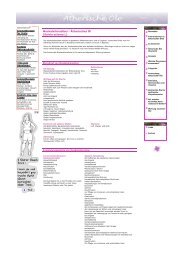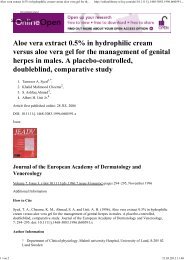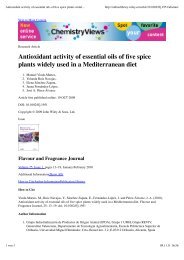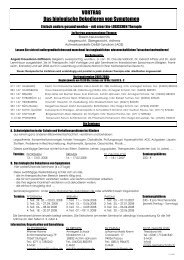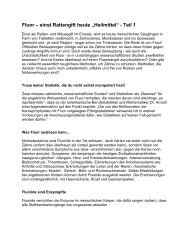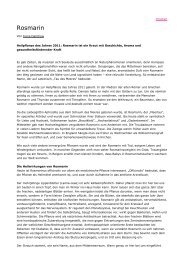Recommendation from the Scientific Committee on Occupational ...
Recommendation from the Scientific Committee on Occupational ...
Recommendation from the Scientific Committee on Occupational ...
Create successful ePaper yourself
Turn your PDF publications into a flip-book with our unique Google optimized e-Paper software.
2.1.3. Biological m<strong>on</strong>itoring<br />
February 2010<br />
European Commissi<strong>on</strong><br />
Employment, Social Affairs and Inclusi<strong>on</strong><br />
<str<strong>on</strong>g>Recommendati<strong>on</strong></str<strong>on</strong>g> <str<strong>on</strong>g>from</str<strong>on</strong>g> <str<strong>on</strong>g>the</str<strong>on</strong>g> <str<strong>on</strong>g>Scientific</str<strong>on</strong>g> <str<strong>on</strong>g>Committee</str<strong>on</strong>g> <strong>on</strong> Occupati<strong>on</strong>al Exposure Limits for diacetyl<br />
No informati<strong>on</strong> <strong>on</strong> biological m<strong>on</strong>itoring of workers is available in <str<strong>on</strong>g>the</str<strong>on</strong>g> open literature<br />
2.2. Acute toxicity<br />
2.2.1. Human data<br />
Exposure to high atmospheric c<strong>on</strong>centrati<strong>on</strong>s may cause CNS depressi<strong>on</strong> (IPCS, 2007). A 36year<br />
old never-smoking man with normal lung functi<strong>on</strong> and normal serum 1-antitrypsin<br />
prepared an urgently needed flavouring product c<strong>on</strong>taining diacetyl, working with <str<strong>on</strong>g>the</str<strong>on</strong>g><br />
heated mixture for several hours in a day in April 2005 (Hendrick 2008). During <str<strong>on</strong>g>the</str<strong>on</strong>g> last few<br />
hours of <str<strong>on</strong>g>the</str<strong>on</strong>g> shift his eyes became sore and reddened, and a sticky c<strong>on</strong>junctival secreti<strong>on</strong><br />
developed so<strong>on</strong> after. Treatment was with steroid and antihistamine; resoluti<strong>on</strong> required<br />
several days. Spirometry was normal in June 2005. However, it decreased and in December<br />
2005, measurements were suggestive of small airway disease. For example, <str<strong>on</strong>g>the</str<strong>on</strong>g> flow between<br />
75% and 25% was 30% of <str<strong>on</strong>g>the</str<strong>on</strong>g> predicted value (Hendrick, 2008)<br />
2.2.2. Animal data<br />
Inhalati<strong>on</strong><br />
In a study <strong>on</strong> <str<strong>on</strong>g>the</str<strong>on</strong>g> acute inhalati<strong>on</strong> toxicity of diacetyl vapour in rats exposed for 4 hours to<br />
levels of 2250, 5200 or 23900 ppm, all animals died at <str<strong>on</strong>g>the</str<strong>on</strong>g> two higher exposure levels (BASF,<br />
1993), with evidence of respiratory tract injury. The LC50 was estimated to lie between 2250<br />
and 5200 ppm. Exposure to 23.9 mg/L (23900 ppm) diacetyl resulted in atelectasis and<br />
oedema of <str<strong>on</strong>g>the</str<strong>on</strong>g> lungs, br<strong>on</strong>chial oedema and hydrothorax. Microscopic findings in <str<strong>on</strong>g>the</str<strong>on</strong>g> mid<br />
and high dose animals included hyperaemia of <str<strong>on</strong>g>the</str<strong>on</strong>g> lung, moderate emphysema,<br />
centrilobular hypertrophy of hepatocytes and degenerative change and necrosis in renal<br />
proximal tubules.<br />
An acute inhalati<strong>on</strong> toxicity study in rats has also been carried out by NIOSH (Hubbs et al.,<br />
2002). Rats were exposed for 6 hours to vapours generated by heating an artificial butter<br />
flavouring and examined 1 day after exposure. GC-MS analysis showed <str<strong>on</strong>g>the</str<strong>on</strong>g> vapours<br />
c<strong>on</strong>sisted of a complex mixture of various organic gases with <str<strong>on</strong>g>the</str<strong>on</strong>g> major comp<strong>on</strong>ents being<br />
diacetyl, acetic acid, acetoin, butyric acid, acetoin dimers, 2-n<strong>on</strong>an<strong>on</strong>e, and delta-alkyl<br />
lact<strong>on</strong>es. Diacetyl was used as a marker of exposure c<strong>on</strong>centrati<strong>on</strong>, and at levels of 285-371<br />
ppm diacetyl extensive respiratory damage was observed, characterised by multifocal,<br />
necrotising br<strong>on</strong>chitis, which was most c<strong>on</strong>sistently present in <str<strong>on</strong>g>the</str<strong>on</strong>g> mainstem br<strong>on</strong>chus. Alveoli<br />
were unaffected. At levels of 203-371 ppm diacetyl generated <str<strong>on</strong>g>from</str<strong>on</strong>g> <str<strong>on</strong>g>the</str<strong>on</strong>g> butter flavouring<br />
mixture, necrosuppurative rhinitis was observed, affecting all four levels of <str<strong>on</strong>g>the</str<strong>on</strong>g> nose. Within <str<strong>on</strong>g>the</str<strong>on</strong>g><br />
posterior two nasal levels (T3 and T4), necrosis and inflammati<strong>on</strong> was principally localized to<br />
<str<strong>on</strong>g>the</str<strong>on</strong>g> nasopharyngeal duct.<br />
Hubbs and co-workers also investigated <str<strong>on</strong>g>the</str<strong>on</strong>g> acute inhalati<strong>on</strong>al toxicity of pure diacetyl<br />
vapour in rats at c<strong>on</strong>centrati<strong>on</strong>s of up to 365 ppm (time weighted average), ei<str<strong>on</strong>g>the</str<strong>on</strong>g>r as six-hour<br />
c<strong>on</strong>tinuous exposures or as four brief, intense exposures over six hours (Hubbs et al., 2008). A<br />
separate experimental group inhaled a single pulse of approximately 1800 ppm diacetyl (92.9<br />
ppm six-hour average). Rats were necropsied 18 to 20 hours after exposure. Exposure to<br />
diacetyl vapours resulted in epi<str<strong>on</strong>g>the</str<strong>on</strong>g>lial necrosis and inflammati<strong>on</strong> in <str<strong>on</strong>g>the</str<strong>on</strong>g> nose, larynx, trachea,<br />
and br<strong>on</strong>chi. Br<strong>on</strong>chi were affected at diacetyl c<strong>on</strong>centrati<strong>on</strong>s of 294.6 ppm or greater; <str<strong>on</strong>g>the</str<strong>on</strong>g><br />
trachea and larynx were affected at diacetyl c<strong>on</strong>centrati<strong>on</strong>s of 224 ppm or greater. Both<br />
pulsed and c<strong>on</strong>tinuous exposure patterns caused epi<str<strong>on</strong>g>the</str<strong>on</strong>g>lial injury, with nasal epi<str<strong>on</strong>g>the</str<strong>on</strong>g>lium being<br />
<str<strong>on</strong>g>the</str<strong>on</strong>g> most sensitive to <str<strong>on</strong>g>the</str<strong>on</strong>g> effects of diacetyl. The authors c<strong>on</strong>cluded <str<strong>on</strong>g>from</str<strong>on</strong>g> <str<strong>on</strong>g>the</str<strong>on</strong>g> results of this<br />
study that <str<strong>on</strong>g>the</str<strong>on</strong>g> NOAEL for inhaled diacetyl in <str<strong>on</strong>g>the</str<strong>on</strong>g> rat was less than 92.9 ppm.<br />
O<str<strong>on</strong>g>the</str<strong>on</strong>g>r routes<br />
6<br />
6


